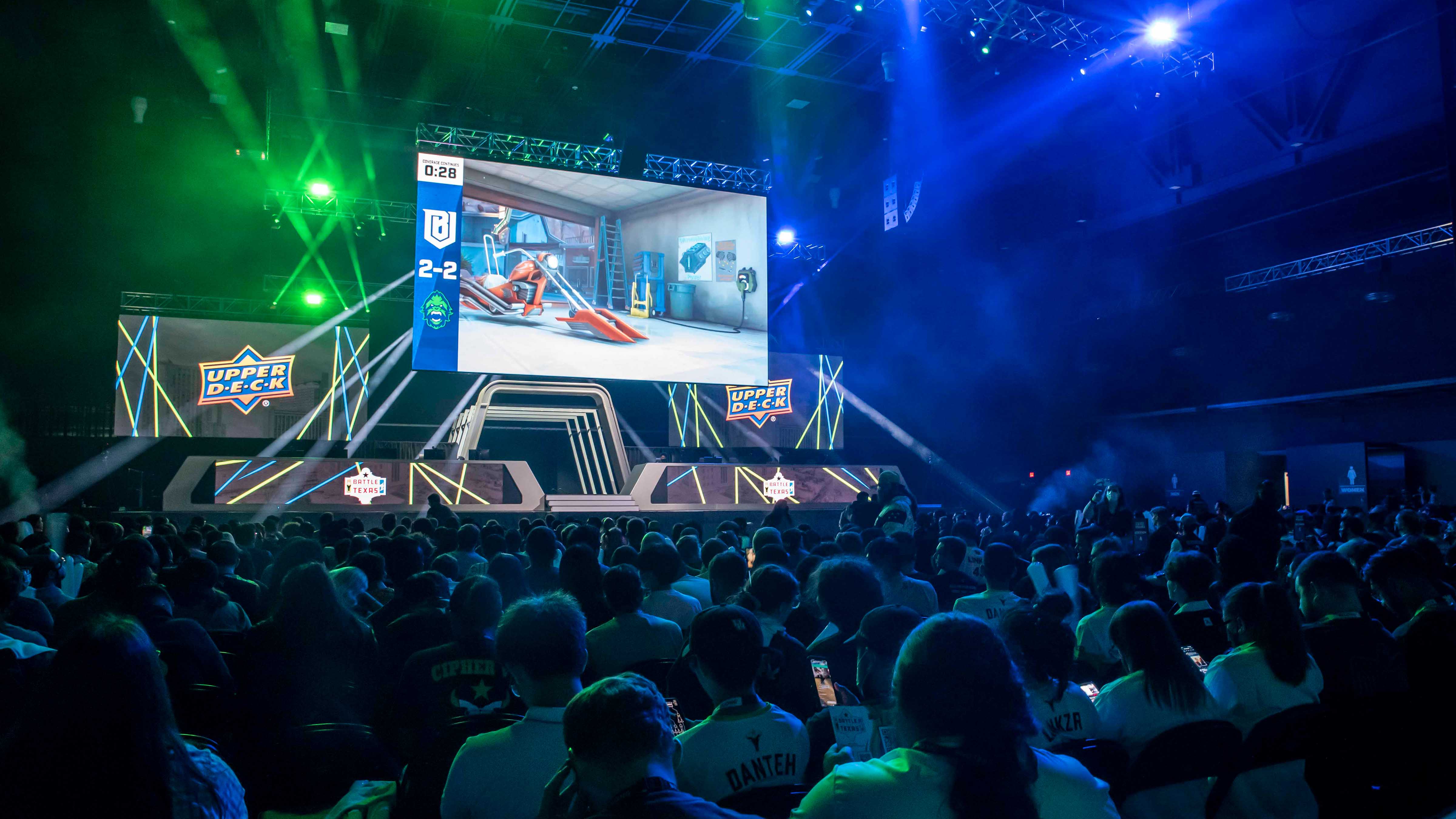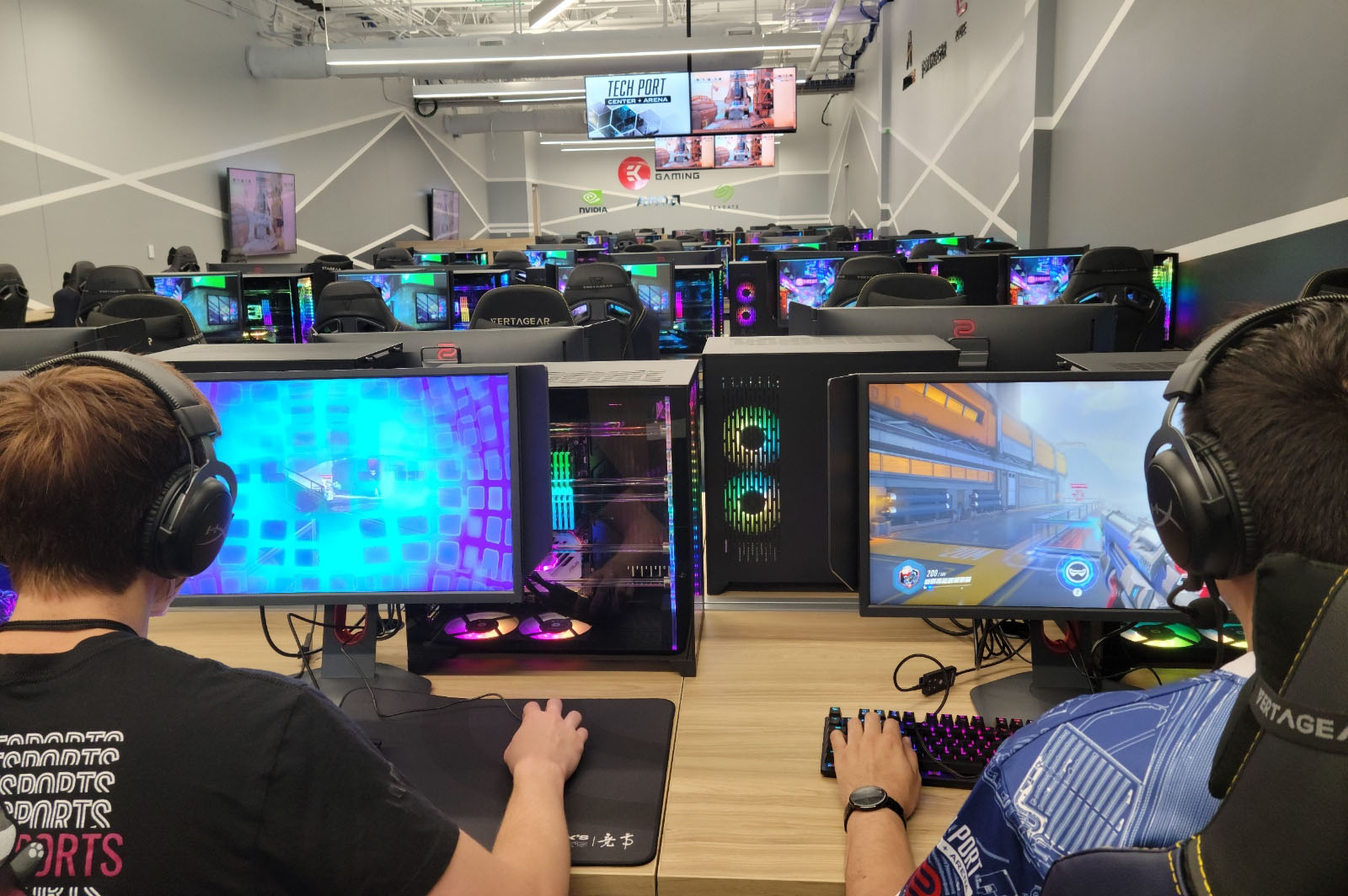Tech Port Center: Esports Gaming at Its Core
While it hosts concerts, sporting events, and conferences, the new Tech Port Center + Arena in San Antonio is optimized for esports.

Esports are the top attraction at the just-opened Tech Port Center + Arena in San Antonio. Managed by entertainment giant ASM Global, the 180,000-square-foot, multipurpose facility, also plays host to concerts, sporting events, and conferences. But the reason AV consultant Anthony James Partners (AJP) was given a $5.2 million AV technology budget was to create an esports playing/viewing venue that would dazzle the fans.
To establish Tech Port Center as a gaming hub, the facility has opened a LAN Gaming Center within its walls. “80s kids would call these places arcades,” said Michael Martin, AJP’s vice president of technology. “Now they’re called cybercafes, gaming lounges, etc.”
[The State of Esports in Higher Education]
In line with modern gaming trends, the cabinet-encased Donkey Kong consoles of the 1980s are now table-mounted gaming stations, each with a 1 Gbps data link to access switches with 40 Gbps links to the facility’s networked computing core. These stations can be used by visitors on an ad hoc basis, or be reserved for use by groups and local esports gaming leagues.
“Each player has an individual station in the gaming center, which includes the PC, display, mouse, keyboard, headset, and chair,” explained Sam Elizondo, Tech Port Center’s director of esports and LAN gaming. “We have 60 of these stations and room for 20 BYOD [Bring Your Own Device] stations. The computers have preloaded games on them already, and you can also play your own titles as well if you own them.”
Competitive Events
In addition to its 60 gaming stations, the LAN Gaming Center has 12 arena gaming stations with 10 Gbps data links to access switches. This allows for faster data transfers, which is why these systems are used for on-stage esports team competitions in front of audiences, usually arrayed in two tables in sets of five. (The system can also be expanded to 18 arena gaming stations for events with three teams of six, all playing together in multiplayer games.)
The esports coverage starts with an array of cameras. At the arena gaming stations, the players’ faces are captured by Marshall POV cameras, while overall action and crowd imagery are shot using Hitachi Z-HD5500 HD broadcast cameras (both fixed and roving). There are also BirdDog robotic cameras positioned around the arena to provide a bird's eye view of the action. “The feeds from them all, plus streams from the gamers’ video monitors, are all sent to our production studio, which houses a combined technical operations center/control room capable of full broadcast-quality TV production," Martin said.
A daily selection of features, industry news, and analysis for AV/IT professionals. Sign up below.

To punch up the visuals, Elizondo said there are 38 moving lights that can be programmed to a producer’s vision. Meanwhile, audio from the gamers’ headsets is accessed through their computer feeds to the production studio, while staff intercoms, floor audio, and color commentator audio/official announcements go through separate pathways. “The on-air talent is housed in two separate breakout rooms located directly behind the stage,” he added.
[Esports: Has Your College Levelled Up?]
Because speed is everything in esports gaming, the Tech Port Center is equipped with an incredibly powerful fiber optic network. It includes a wired network with 40G redundant links from core to edge, plus 5G cellular distributed antenna system (DAS) high-density Wi-Fi and a broadcast network with SDI and NDI transports. The facility also has dark single mode fiber throughout the facility and dark Cat6 cabling between its intermediate distribution frames (IDFs) to connect portable gaming show rig deployments.
Polished Productions
Once the visuals (and floor audio) get back to the production studio, the crew selects and mixes the feeds just like they would for any sporting event. “We have a NewTek TriCaster 2 Elite switcher that handles the video feeds to the in-arena LED displays and for streaming to the web,” Martin said. “The output goes to a Ross Video system to deliver content to our large LED displays and Samsung HDTVs throughout the facility.”
The monitors that matter most to fans are a trio of SNA 4mm LED screens mounted behind the competing gamers’ tables. The center screen measures just over 19x34 feet and is flanked by two 13x26-foot screens. These can serve as part of a three-monitor display or operated separately and angled to serve different areas of the arena. The Tech Port Center also has 74 Samsung monitors that are controlled by UCView CMS signage software, plus exterior LED displays for messaging and advertising. Sound is delivered using a high-power JBL Cinema 7.1 surround sound loudspeaker system.
[Higher Ed Esports Programs Need Support from AV/IT Experts]
Make no mistake: The production values during Tech Port Center esports’ competitions are as polished as any major league sports event. In fact, during an esports event, the main camera-based feed is switched by a professional technical director, who is backed by a graphics expert adding lower-third CG titles, audio director managing the sound, and another technician selecting the feeds for the venue’s various monitors.
“We even have video replay and slow motion,” said Martin. “We run both just as you would in football, and use the lower-third of the screen to crawl information, plus pop-up relevant scores, wins/losses, you name it.”
Limiting Latency
The team at Tech Port Center is able to bring esports right into the action during competitive events, which can run for hours at a time over one or two days. “Most of the time, what you’re watching on the big screens is the actual game play, as well as seeing how the competitive players are reacting as things progress,” Martin explained. “The players can become quite animated as they either succeed or get killed as the game progresses.”

To keep these productions going smoothly with all the signal paths involved, AJP has done everything it can to minimize signal latency in the venue’s network. “Latency can't be allowed to exist,” said Martin. “Minimizing it came down to ensuring that the network jacks and every other physical element in the network was perfect. After all, the competitive gaming system is a single-mode fiber optic backbone that connects those 10-gig switches to the NIC [network interface controller] cards. Something as simple as a jack being improperly terminated or even not quite pressed down enough could actually cause latency in it.”
AJP spent weeks testing the Tech Port Center network—from the gaming stations at one end to the switches and the NICs at the other—to make sure the system exceeded expectations. “We didn’t experience any signal latency in the network once we were done,” Martin said. “And as of now, we've not seen any at all.”
James Careless is an award-winning freelance journalist with extensive experience in audio-visual equipment, AV system design, and AV integration. His credits include numerous articles for Systems Contractor News, AV Technology, Radio World, and TV Tech, among others. Careless comes from a broadcasting background, with credits at CBC Radio, NPR, and NBC News. He currently co-produces/co-hosts the CDR Radio podcast, which covers the Canadian defense industry. Careless is a two-time winner of the PBI Media Award for Excellence.

